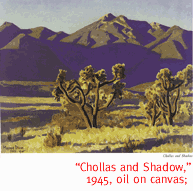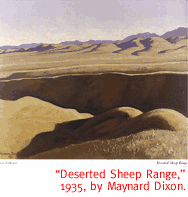

|

A Retrospective Of Works By The Late Maynard Dixon.
By Margaret Regan
THE FAMOUS WESTERN painter Maynard Dixon lived the last
six years of his life in Tucson, on land he bought from the Ronstadts
along Prince Road. He painted the golden light of autumn, the
blue-beige Catalinas, and, this being the early 1940s, the still-empty
desert stretching out before the mountains.
 "Chollas and Shadow," one of the last oils he finished
before his death in 1946, is a classic Tucson scene. The yellow-gilded
chollas are thrust up against the blue mountain, which in turn
lies against the turquoise-blue sky. But it's also classic Dixon:
If the chollas are a little busy, the desert and the mountains
have been reduced to their simplest forms. Alternating between
shadow and light, the landscape heads toward the horizon in an
austere series of angular planes and horizontal lines.
"Chollas and Shadow," one of the last oils he finished
before his death in 1946, is a classic Tucson scene. The yellow-gilded
chollas are thrust up against the blue mountain, which in turn
lies against the turquoise-blue sky. But it's also classic Dixon:
If the chollas are a little busy, the desert and the mountains
have been reduced to their simplest forms. Alternating between
shadow and light, the landscape heads toward the horizon in an
austere series of angular planes and horizontal lines.
Dixon was a realist, but a pared-down one, and his mature work
has almost none of the fussiness of popular cowboy art. He married
the angular Western landscape with the spareness of modernism,
translating its familiar forms into near-abstractions of shape
and color. "Deserted Sheep Range," a 1935 oil on canvas,
is an almost schematic rendering of a barren California wilderness.
The foreground's curving hillocks in yellow ochre give way to
an undulating band of burnt sienna; above this are rolling dunes
bathed in light, beyond them the sky. In his hands, the West's
familiar big skies, majestic clouds and infinite plains are still
skies, clouds and plains, but they're also perfect starting points
for experiments of color against color, shape against shape. As
a result, Dixon's in the strange position of being admired both
by the Western-art crowd and devotees of pure painting.
A new show at Tucson's Medicine Man Gallery, Mesas, Mountains
& Man: The Western Vision of Maynard Dixon, provides an
opportunity to explore this apparent contradiction. Gathering
more than 100 oils and drawings from museums, private collectors
and galleries, and more than a year in the making, the exhibition
traces the whole of Dixon's career. Born in 1875 in California,
the painter grew up in the San Joaquin Valley. His boyhood impressions
of that flat, open country, he later said, were responsible for
his passion for the horizontal line so crucial to his work.
As a young man, Dixon worked as an illustrator for Sunset
magazine, and undertook assorted mural commissions, including
the uncharacteristic "Oakland Technical High School Mural,"
included in the show. It's an oil whose thin color stains the
linen cloth, and it's an atypically romantic depiction of a California
hacendero on horseback. According to Mark Sublette, proprietor
of Medicine Man, Dixon did a quartet of murals for the railroad
station in downtown Tucson around 1907; three of them are now
safely deposited at the Arizona Historical Society.
 When he made the transition to painter, Dixon became an itinerant,
roaming the West for months on end, making plein-air oil sketches
and drawings, before returning to his studio in San Francisco.
Although he made two forays into Montana, he favored the desert
Southwest, where the bare bones of the land are so famously visible.
When he made the transition to painter, Dixon became an itinerant,
roaming the West for months on end, making plein-air oil sketches
and drawings, before returning to his studio in San Francisco.
Although he made two forays into Montana, he favored the desert
Southwest, where the bare bones of the land are so famously visible.
It took him a while to get to the masterful flatness of his late
work. Influenced by European painters, he early on became an impressionist
cowboy, painting such works as "The Palomino Mare" with
all the broken brushstrokes, thick paint and glittery colors of
a Monet. This 1914 work, depicting a wrangler going after a wild
horse, is not a bad painting, but neither is it a good match between
style and subject. It's still too decorative--one thinks of a
French garden--and too far removed from the rigor Dixon was to
find later.
Sublette, the show's curator, locates what he calls Dixon's post-impressionist
style in the 1920s. Like a Cézanne, who rebelled against
earlier artists' fleeting impressions of light and color, Dixon
started aiming for solid structures. "Saguaros at Sunset,"
an Arizona painting from 1925, is still heavily painted, but it
nonetheless conveys the sturdy cylindrical volume of the cacti.
Dixon had long sketched Native Americans (he lived among the Hopi
periodically in the 1920s), and in the '30s he tried his hand
at social commentary. He was married at the time to Dorothea Lange,
the photographer known for her Depression-era images of the down-and-out.
"No Place to Go," a 1935 oil, has a homeless man leaning
against a stylized fence on a curving bit of land. This painting
marks one of the few times Dixon ever portrayed the Western landscape
as closed-in; instead of his usual infinite horizons, this one
has claustrophobic mountains shutting off escape.
 After this brief side trip into unfamiliar social territory,
Dixon devoted the rest of his life to the open land. In his last
10 years, he pared everything down, bringing his technique into
harmony with the jagged earth he wanted to paint, purging distractions
from his paintings. His brushstrokes went from rough to smooth,
his shapes got broader and flatter, his lights lighter, his darks
darker. True, there were still some conventional genre scenes,
such as "Farmyard and Cottonwood" (1941), but for the
most part Dixon held steady to the raw land, to a lonely West
bereft of people.
After this brief side trip into unfamiliar social territory,
Dixon devoted the rest of his life to the open land. In his last
10 years, he pared everything down, bringing his technique into
harmony with the jagged earth he wanted to paint, purging distractions
from his paintings. His brushstrokes went from rough to smooth,
his shapes got broader and flatter, his lights lighter, his darks
darker. True, there were still some conventional genre scenes,
such as "Farmyard and Cottonwood" (1941), but for the
most part Dixon held steady to the raw land, to a lonely West
bereft of people.
The late Utah paintings, done in the early '40s, are perfect
summations of his aesthetic. "Sunlit Cliffside," 1942,
is a long view of towering rocks in the light, rose against blue;
"November Morning," also 1942, is a composition in blues
and beiges, almost incidentally shaped into cliffs and mountains.
"Zion Canyon," 1940, takes the red rocks and makes them
soar against the blue sky. These works are a pure pleasure for
lovers of paint, and for voluptuaries of the West's once wide-open
spaces.
Mesas, Mountains & Man: The Western Vision of Maynard
Dixon continues through Thursday, December 24, at the
Medicine Man gallery, 7000 E. Tanque Verde Road, Suite
7. Hours are 10 a.m. to 5 p.m. Monday through Saturday, and 1
to 4 p.m. Sunday. For more information, call 722-7798.

|
 |





